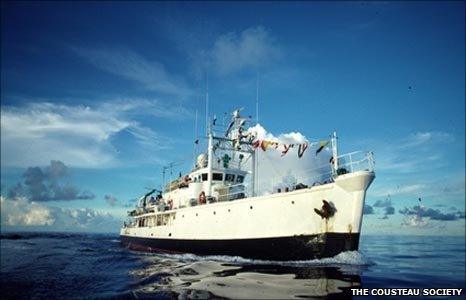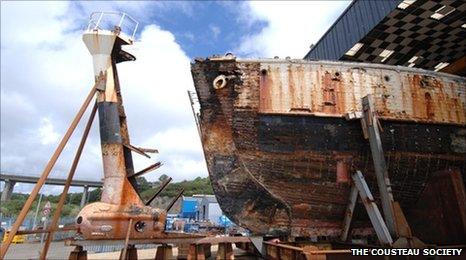Jacques Cousteau's ship Calypso is to be relaunched
- Published

The Calypso will be relaunched as a "touring educational exhibition"
To mark the centennial of marine explorer Jacques Cousteau's birth, the society established in his name will relaunch his ship, the Calypso.
The vessel was badly damaged in 1996, when a barge accidentally rammed into it in the port of Singapore.
It is now being repaired and the Cousteau Society says it will become a "touring educational exhibition".
The ship, originally a British minesweeper, was adapted into a "mobile oceanography laboratory" in 1950.
It was bought by Irish millionaire and former MP Thomas Loel Guinness, a descendent of the founder of the Guinness brewery, who outfitted it to Captain Cousteau's specifications and leased it to him for a symbolic one franc per year.
The former naval officer turned explorer caught some of the first glimpses of deep sea life from aboard the ship.
This was aided by Calypso's "false nose" that Captain Cousteau and his team used as an underwater observation chamber.
He also brought the life of the oceans to public attention with his TV series, films and several books.
In 1943, Captain Cousteau and the French engineer Emile Gagnan developed the aqualung, the breathing apparatus that first supplied oxygen to divers, allowing them to stay underwater for several hours.
Captain Cousteau died in 1997. His eponymous society plans to mark the centennial of his birth with a year-long celebration.
This will include a new filming expedition in the Mediterranean Sea - to document the changes since Captain Cousteau made one of his first films there in the 1940s.
His youngest son, Pierre-Yves Cousteau said: "If he were alive today, my father would be gratified by the creation of marine protected areas in many countries and by the growing community of scientists working to advance understanding and conservation of ocean biodiversity.
"However, I know he would also be distressed by the ongoing pillage of oceans by industrialised fisheries [and] by the catastrophes that stem from exploiting off-shore oil resources."

The ship is being refurbished at a shipyard in Brittany